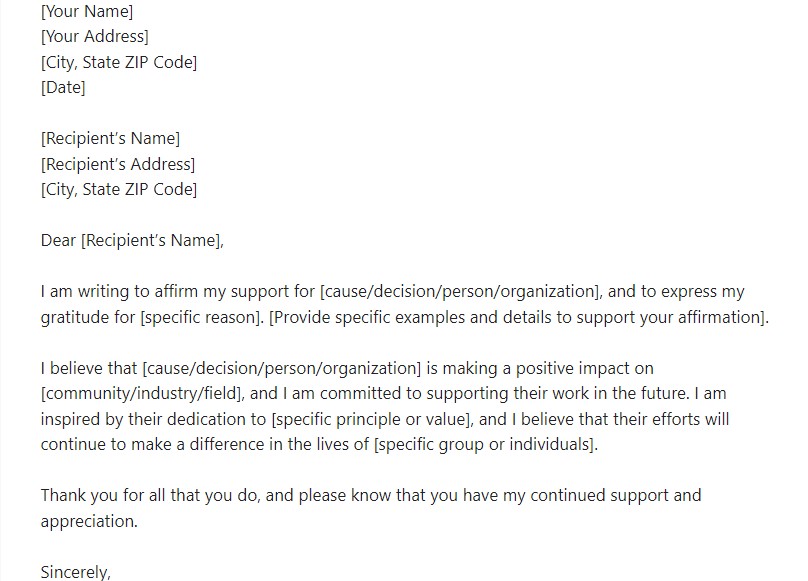An affirmation letter is a document used to confirm or acknowledge an agreement, understanding, or action taken by a person or an organization. It can be used for various purposes, such as confirming employment or confirming receipt of goods or services. Writing an effective affirmation letter requires careful consideration of the recipient’s needs and expectations. Here’s a guide to help you understand what affirmation letters are and how to write them effectively. This guide includes tips and examples to help you get started.
I assume you mean an “affirmation letter” as a letter in which one affirms something, rather than an “affidavit letter,” which is a legal document containing a sworn statement of fact.
Here are some frequently asked questions about affirmation letters:
Q: What is an affirmation letter?
A: An affirmation letter is a written statement in which the writer affirms or confirms something, such as their commitment to a particular course of action, their agreement with a decision, or their belief in a particular principle or value.
Q: When might I need to write an affirmation letter?
A: You might be asked to write an affirmation letter in a variety of situations, such as:
– To confirm your acceptance of a job offer or other employment terms
– To express your support for a colleague, friend, or family member who is going through a difficult time
– To reaffirm your commitment to a particular cause or organization
– To express your agreement with a decision made by a group or organization
– To confirm your understanding of a legal agreement or contract
Q: What should I include in an affirmation letter?
A: The content of an affirmation letter will depend on the specific situation and purpose, but generally it should include:
– A clear statement of what you are affirming or confirming
– The reasons or motivations behind your affirmation
– Any additional information or details that support your affirmation
– A sincere and positive tone
– Any specific requests or actions you would like the recipient to take in response to your affirmation
Q: How should I format an affirmation letter?
A: There is no standard format for an affirmation letter, but it should generally be written in a professional, formal style. You may want to include a header with your name, address, and contact information, followed by the recipient’s name and address. Begin with a clear and concise statement of what you are affirming, and use specific details and examples to support your affirmation. End with a closing that expresses your appreciation or well wishes.
Q: Is an affirmation letter legally binding?
A: An affirmation letter is generally not a legally binding document, unless it is part of a formal agreement or contract. However, it can be a powerful tool for expressing your commitment, support, or agreement in a way that is clear and meaningful.
Here are some steps to follow when writing an affirmation letter:
1. Start with a clear statement of what you are affirming: Begin your letter with a clear and concise statement of what you are affirming or confirming. This could be your commitment to a particular cause, your agreement with a decision, or your support for a colleague or friend. Be specific and avoid vague or general statements.
2. Use specific examples and details to support your affirmation: Provide specific examples and details to support your affirmation. This could include your past experiences or actions, the impact that the person or organization has had on you or others, or the reasons why you are making this affirmation.
3. Keep a positive and sincere tone: Use a positive and sincere tone throughout your letter. Be authentic and genuine in your expression of support or agreement, and avoid using language that could be perceived as insincere or patronizing.
4. End with a closing that expresses appreciation or well wishes: End your letter with a closing that expresses your appreciation or well wishes. This could include a thank you for the person or organization’s work, a statement of continued support, or a wish for success in their future endeavors.
5. Proofread and edit your letter: Before sending your affirmation letter, be sure to proofread and edit it carefully. Check for spelling and grammar errors, and make sure your tone and content are appropriate for the intended audience and purpose of the letter.
Here is a sample outline for an affirmation letter:
[Your Name]
[Your Address]
[City, State ZIP Code]
[Date]
[Recipient’s Name]
[Recipient’s Address]
[City, State ZIP Code]
Dear [Recipient’s Name],
I am writing to affirm my support for [cause/decision/person/organization], and to express my gratitude for [specific reason]. [Provide specific examples and details to support your affirmation].
I believe that [cause/decision/person/organization] is making a positive impact on [community/industry/field], and I am committed to supporting their work in the future. I am inspired by their dedication to [specific principle or value], and I believe that their efforts will continue to make a difference in the lives of [specific group or individuals].
Thank you for all that you do, and please know that you have my continued support and appreciation.
Sincerely,
[Your Name]
